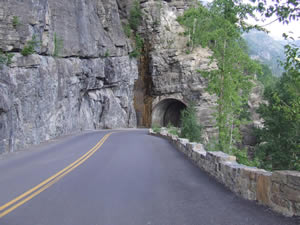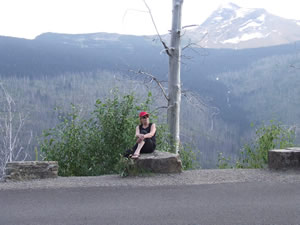© 2008-2024
All Rights Reserved |
|
|
Glacier National Park
Road Trip - August, 2009
|
By mid summer, Doreen was having "road trip withdrawal" so she asked me if I wanted to give Logan Pass in Montana another try over the August long weekend. Twice before on trips, we'd tried, but even in early July, the Going to the Sun road had been closed due to snow. Finally, in the heat of August, we were able to make the run. |
|
| Calgary to Glacier National Park |
August long weekend we packed up on Saturday morning heading for Glacier National Park and Logan Pass over the Going-To-The-Sun Highway. After several years of trying, it finally happened - in the middle of the summer. We had missed our usual June road trip so it felt really good to be on the trail.
Glacier National Park borders Waterton Lakes National Park in Canada. The two parks are known as the Waterton-Glacier International Peace Park, and were designated as the world's first International Peace Park in 1932. Both parks were designated by the United Nations as Biosphere Reserves in 1976, and in 1995 as World Heritage sites.
It was our intention to cross into the States at the Waterton Park Chief Mountain crossing but shortly before the border we were turned around due to a tragic accident ahead of us. This should have been taken as an omen, but we naively backtracked and headed for the border crossing at Carway, along with everyone else heading south. |
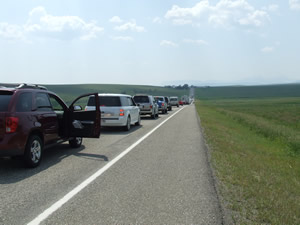 |
The lineup was like none we have ever been involved in and it took us over two hours just to get up to the gate house. This was the first time we'd crossed since the US Customs required everyone driving to now carry a passport. |
Border Disrespect
After all the years of travelling thru customs, we got a taste of what it feels like to be under suspicion and interrogated like they were expecting us to be criminals. Everyone (except returning Americans) was questioned, had their belongings poked thru, including the dog sniffer around each vehicle. This, in itself, was time consuming and frustrating, however, we would not find out the worst of it until we were many miles away in Glacier Park. We pulled over to fill our coffee and grab a bite to eat. It was then we discovered that not only did the border patrol inspect our cooler, they took the liberty of putting a full litre of open cream back in upside down. Everything in the cooler was ruined, not to mention Doreen had no cream for her coffee. It is probably fortunate that we were well out of earshot of the border guard.
The cream was in a zip lock bag because it had been opened, so there is absolutely no doubt that whoever did it knew full well what they were doing. This action was an intentional disrespect of personal property and totally uncalled for. We were not rude, we answered their questions honestly. We do not have criminal records. Our passports were in order. We did not have anything illegal with us. Two senior ladies travelling to see Glacier National Park over a long weekend did not deserve this careless treatment. And if we were to file a complaint, one wonders what kind of blacklisting would follow. Travelling is too important to us. |
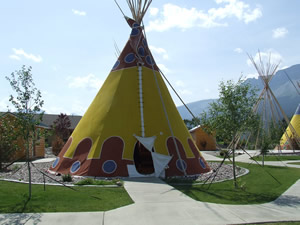 |
TeePee Motel, St. Mary, Montana
Just before the park road, we found a very unique teepee motel. We wandered around inspecting it and it was tempting to scrap our plans and just stay there.
The teepees were well appointed and extremely inviting. Food for thought for another year when we have more time. |
|
| Glacier National Park |
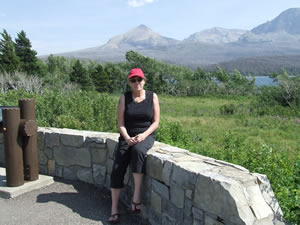 |
Triple Divide Peak
From it's three-sided pyramid, rain and snowmelt travel to three major river systems and enter the Pacific Ocean, Hudson Bay, and Gulf of Mexico. |
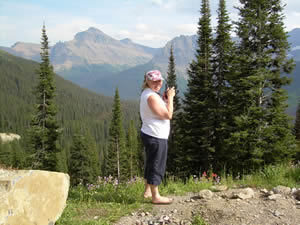 |
The scenery leading up to the park entrance was absolutely beautiful, probably the prettiest mountain area we have travelled. It was hard to believe, but it would just get better and better as we cruised along. We stopped so many times along the road to view and take pictures, it took us a while to get to the park. The best, however, was yet to come. |
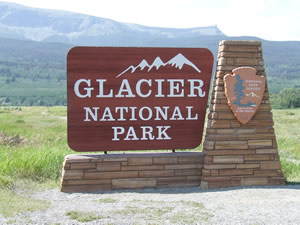 |
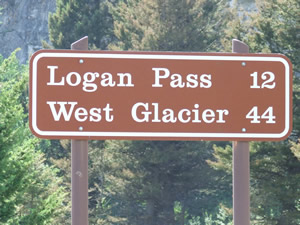 |
Going-To-The-Sun Highway
The road officially received its name, “The Going-to-the-Sun Road,” during the 1933 dedication at Logan Pass. The road borrowed its name from nearby Going-to-the-Sun Mountain. Local legend, and a 1933 press release issued by the Department of the Interior, told the story of the deity, Sour Spirit, who came down from the sun to teach Blackfeet braves the rudiments of the hunt. On his way back to the sun, Sour Spirit had his image reproduced on the top of the mountain for inspiration to the Blackfeet. An alternate story suggests a white explorer in the 1880s concocted the name and the legend. No matter which version is accurate, the road named Going-to-the-Sun still inspires all who travel it. |
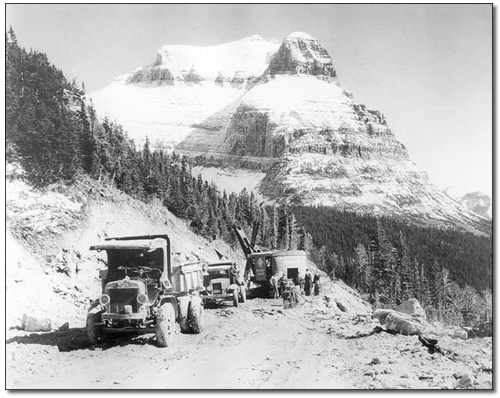
Construction of the Road - 1932 |
Logan Pass
Logan Pass is the highest point on the Going-to-the Sun Road at 6,646 feet. Just east of the pass, an area known as Big Drift often records over 100 feet of snowfall, much of which has been pushed over the continental divide by the prevailing westerly winds during the winter. The pass is closed during the winter due to avalanche hazards and the virtual impossibility of keeping the Going-to-the-Sun Road open.
The road is one of the most difficult roads in North America to snowplow in the spring. Up to 80 feet of snow can lie on top of Logan Pass, and more just east of the pass where the deepest snowfield has long been referred to as Big Drift. The road takes about ten weeks to plow, even with equipment that can move 4000 tons of snow in an hour. The snowplow crew can clear as little as 500 feet of the road per day. On the east side of the continental divide, there are few guardrails due to heavy snows and the resultant late winter avalanches that have repeatedly destroyed every protective barrier ever constructed.
The road is generally open from early June to mid October. Note though, that we have been here in late June and early July and found it still closed. |
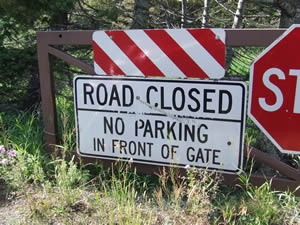 |
The Road is Open!
It was with great delight that we passed "through" the gate that had thwarted us twice before. It was finally open and we were at long last going to see it.
No "road closed" sign for us this time! We gave a "whoop" and drove on through. |
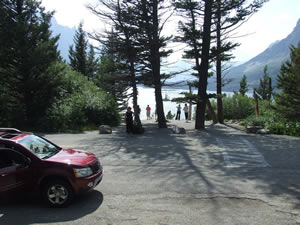 |
St. Mary Lake
Saint Mary Lake is the second largest lake in Glacier National Park. Located on the east side of the park, the Going-to-the-Sun Road parallels the lake along its north shore. The lake is 9.9 miles long and 300 feet deep. The waters of the lake rarely rise above 50 °F. During the winter, the lake often freezes completely over with ice up to 4 feet thick. |
 |
Sunrift Gorge
Sunrift Gorge was formed when a small stream cut through a natural break in the rock. It is a straight steep canyon cut through the bedrock just 200 feet off the main road. Also at this location one of the most beautiful bridges along the entire Going to the Sun Road is found. |
 |
Going, Going, Gone
From a distance, snowfields are often mistaken for glaciers until the annual snowfall melts away. As the global climate warms, however, the glaciers are melting as well. Today we see only 25% of the ice that existed in 1850 and projections are that the park's glaciers will be gone by 2030. Of the estimated 150 glaciers present in 1850, approximately 26 remain. |
 |
Get it Right Woman
It was at this point some dude on a bicycle who didn't speak a lick of English wanted Doreen to take his picture - getting the glacier in the background. She couldn't see a thing through his camera and the pictures she took of the white glacier against a white sky simply weren't "to his satisfaction". How she ended up holding his bicycle so he could look through his camera is still a mystery to me!! Despite the language barrier, his message was clear - Dumb Broad! |
The Visitor's Centre
We were greeted by a marmot at the visitors centre. He was sitting unafraid on the rock perch beside the steps to the centre, putting on quite a show with his squawking repertoire. Although the marmot seemed quite tame, I was unable to get closer to him. Doreen relaxed in the sunshine as I wandered around snapping photos of the flowers and gardens around the centre and trying to get a close-up shot the marmot. Eventually, I did manage to catch him peeking out of the shrub. |
 |
 |
Lake McDonald Area
Lake McDonald is the largest lake in Glacier National Park. It is approximately 10 miles long, over a mile wide and 472 feet deep, filling a valley formed by a combination of erosion and glacial activity. Lake McDonald lies on the west side of the Continental Divide and The Going-To-The-Sun Road parallels the lake along its southern shoreline. The rest area overlooks the aftermath of a huge fire.
The summer of 2003 was the most significant fire season in the history of Glacier National Park. 136,000 acres burned in the park after a five year drought and a summer season of almost no precipitation. This was the most area transformed by fire since the creation of the park in 1910. |
|
| The Flowers of Glacier National Park |
The flowers in the park and surrounding area were in full bloom. We stopped several time to take pictures.
Glacier National Park is home to at least 1,132 species of vascular plants. There are 20 different tree species, 93 woody shrubs or vines, 88 annual or biennial plant species, and 804 types of perennial herbs. The park also has at least 855 species of mosses and lichens. There are likely more than 200 species of fungi. Sixty-seven vascular and 42 non-vascular plant species found in Glacier Park are listed as "sensitive" by the State of Montana. |
|
|
|














